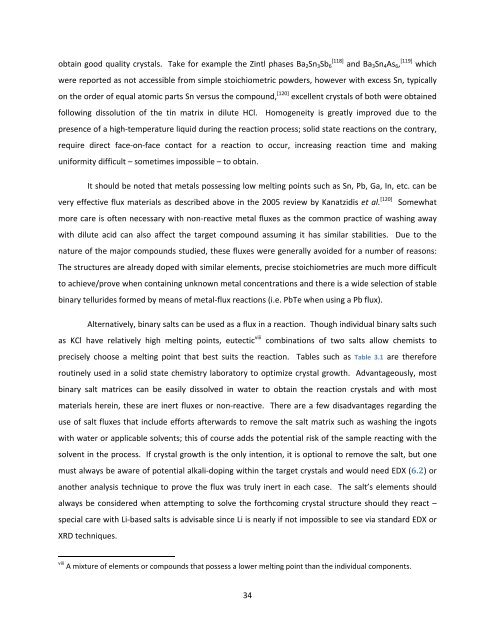Exploration and Optimization of Tellurium‐Based Thermoelectrics
Exploration and Optimization of Tellurium‐Based Thermoelectrics
Exploration and Optimization of Tellurium‐Based Thermoelectrics
Create successful ePaper yourself
Turn your PDF publications into a flip-book with our unique Google optimized e-Paper software.
obtain good quality crystals. Take for example the Zintl phases Ba2Sn3Sb6 [118] <strong>and</strong> Ba3Sn4As6, [119] which<br />
were reported as not accessible from simple stoichiometric powders, however with excess Sn, typically<br />
on the order <strong>of</strong> equal atomic parts Sn versus the compound, [120] excellent crystals <strong>of</strong> both were obtained<br />
following dissolution <strong>of</strong> the tin matrix in dilute HCl. Homogeneity is greatly improved due to the<br />
presence <strong>of</strong> a high‐temperature liquid during the reaction process; solid state reactions on the contrary,<br />
require direct face‐on‐face contact for a reaction to occur, increasing reaction time <strong>and</strong> making<br />
uniformity difficult – sometimes impossible – to obtain.<br />
It should be noted that metals possessing low melting points such as Sn, Pb, Ga, In, etc. can be<br />
very effective flux materials as described above in the 2005 review by Kanatzidis et al. [120] Somewhat<br />
more care is <strong>of</strong>ten necessary with non‐reactive metal fluxes as the common practice <strong>of</strong> washing away<br />
with dilute acid can also affect the target compound assuming it has similar stabilities. Due to the<br />
nature <strong>of</strong> the major compounds studied, these fluxes were generally avoided for a number <strong>of</strong> reasons:<br />
The structures are already doped with similar elements, precise stoichiometries are much more difficult<br />
to achieve/prove when containing unknown metal concentrations <strong>and</strong> there is a wide selection <strong>of</strong> stable<br />
binary tellurides formed by means <strong>of</strong> metal‐flux reactions (i.e. PbTe when using a Pb flux).<br />
Alternatively, binary salts can be used as a flux in a reaction. Though individual binary salts such<br />
as KCl have relatively high melting points, eutectic viii combinations <strong>of</strong> two salts allow chemists to<br />
precisely choose a melting point that best suits the reaction. Tables such as Table 3.1 are therefore<br />
routinely used in a solid state chemistry laboratory to optimize crystal growth. Advantageously, most<br />
binary salt matrices can be easily dissolved in water to obtain the reaction crystals <strong>and</strong> with most<br />
materials herein, these are inert fluxes or non‐reactive. There are a few disadvantages regarding the<br />
use <strong>of</strong> salt fluxes that include efforts afterwards to remove the salt matrix such as washing the ingots<br />
with water or applicable solvents; this <strong>of</strong> course adds the potential risk <strong>of</strong> the sample reacting with the<br />
solvent in the process. If crystal growth is the only intention, it is optional to remove the salt, but one<br />
must always be aware <strong>of</strong> potential alkali‐doping within the target crystals <strong>and</strong> would need EDX (6.2) or<br />
another analysis technique to prove the flux was truly inert in each case. The salt’s elements should<br />
always be considered when attempting to solve the forthcoming crystal structure should they react –<br />
special care with Li‐based salts is advisable since Li is nearly if not impossible to see via st<strong>and</strong>ard EDX or<br />
XRD techniques.<br />
viii A mixture <strong>of</strong> elements or compounds that possess a lower melting point than the individual components.<br />
34
















